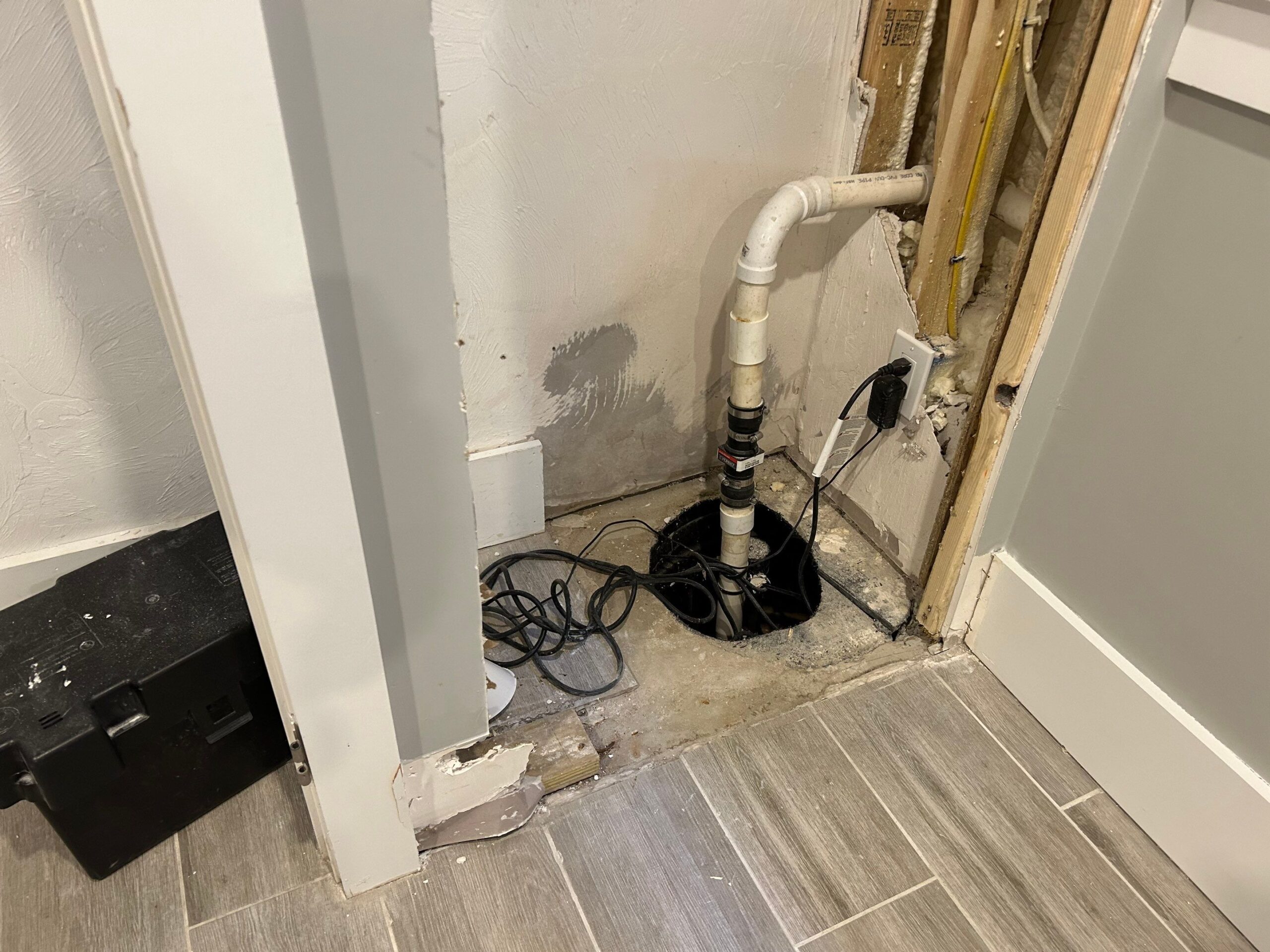It’s an unfortunate fact that anything mechanical will eventually break down and sump pumps are no exception. Sump pump failure will eventually happen to every system. If you find your sump pump not working, don’t panic too much. There are steps we can take to identify, diagnose and potentially fix them.
What Is A Sump Pump?
A sump pump is a fairly straightforward device which moves water away from your property before it has a chance to wreak havoc on your interior.
A sump pump consists of a motor, an impellor, a discharge line, and a float switch.
When the float switch rises high enough, the motor is turned on, spinning the impellor which creates an area of low pressure, pulling water into and through the discharge line. The discharge line directs the water to a designated area of appropriate drainage in your yard.
Why Is My Sump Pump Not Working?
How do you tell if your sump pump isn’t working? You test it.
Simply pour a bucket of water into the sump pit and ensure that the motor starts, then check along the discharge line to ensure everything is slowing freely. If you find that your sump pump has stopped working, it’s time to dig a little deeper.
1. Power Failure
As electrical devices, sump pumps need a constant power supply. Simply put; no power, no pump.
It might sound silly but probably the most common problem is simply…it’s been unplugged. Always check your socket before going any further!
It’s a bit of an irony that one of the most common sources of sump pump problems can be caused by the very conditions that mean you’re most likely to need them working. Storms cause a rise in groundwater level but they also often knock out powerlines.
Of course, bad weather isn’t the only potential cause of power failure and sump pump problems. If there’s no sign of a power outage, check your circuit breaker and GFCI outlet for a tripped circuit.
Solutions:
- Always keep your pump plugged in.
- Plug your pump into it’s own designated circuit to avoid blown fuses.
- Install a backup battery system for your sump pump.
- Keep extra batteries charged during big storms.
- Install a whole home generator or keep a portable one handy.
2. Float Switch Problems
Your sump pump problems might be caused by an incorrectly set float switch.
Float switches are simple mechanisms- they sit in the sump pit and when there’s enough water around them to make them float, they turn on the pump. Any issues that arise with your float switch can cause issues with your pumps ability to turn on or off.
Float Switch Set Too High
If you look into your sump and find that there is a lot of water but your sump pump isn’t running, it could be that your switch has been set too high. This means that your pump will be kicking in too late to effectively divert the water away before it becomes an issue.
Float Switch Set Too Low
On the other hand, your switch might be set too low. This means that your pump will start up when it doesn’t really need to. This can cause excess cycles and cause your pump to wear out faster. Sometimes simply adjusting your float switch above the water table can drastically reduce your daily cycles.
Stuck Float Switch
Sometimes something will find its way into your sump pit and block the switch from rising or falling at all. This kind of sump pump failure is usually a fairly straightforward fix. Avoid any wires or tubes hanging into your pit that could obstruct the operation of your float switch.
Switch Failure
Of course, even a mechanism as simple as a float switch can malfunction. When this happens your pump may be stuck permanently on or off until you replace the part.
Solutions
Float switch issues are probably the simplest causes of sump pump problems to fix.
Open up your sump pit and take a look and then:
- If the switch has been set too high or too low, simply adjust it to the correct level.
- Check that there’s nothing interfering with the free movement of your float switch. If there is, remove it.
- If nothing happens when you manually raise and lower the float, or it seems to be jammed, it’s time for a replacement.
3. Overwhelmed Pump
Of course, it may not be “failure” per se when you find yourself with a sump pump that isn’t working properly.
All pumps have a maximum capacity of water that they can move. If your pump is overloaded you could face flooding issues.
Solutions
If you find your sump pump can’t cope with the amount of water that you need it to move you have two options:
- Install a bigger pump
- Install a second pump
Either of these options will allow your system to pump more water. If you’re not sure which option is right for your property, consult a professional.
4. Clogged Discharge Lines
Another common cause of sump pump failure is a clogged discharge line. A blockage somewhere between your pump and where it pumps the water to will cause the system to back up and eventually break down.
It might be a frozen pipe or it could be simply some debris, such as iron ochre, which has worked its way through the system until it gets itself stuck.
Solution
Regular maintenance will help prevent clogs and installing a discharge line with proper pitch will help prevent water freezing in colder climates.
It’s also a good idea to ensure that your sump pit is fully covered (but still accessible) to help avoid debris getting into the system in the first place. An open sump is not just unsightly, it’s a disaster waiting to happen.
5. Lack of Maintenance
It’s an unfortunate fact of life that any system will break down if it’s not properly maintained. This goes double for anything with moving parts and sump pumps are no exception.
Debris and wear and tear will happen over time, but you can minimize their effects by scheduling an annual check-up for your sump pump.
Solution
Annual Maintenance from a professional who is well versed in sump pump operation is pivotal in ensuring the longevity of your sump pump system. At Drycrete we:
- Check sump pump operation (including all float switches)
- Ensure the discharge line is free and clear of damage
- Check for and remove any sediment and debris
- Adjust your float switch if necessary
- Inspect your French drains if you have any
6.Improper Installation
Another possibility if your sump pump isn’t working is that it was never installed correctly in the first place.
Installing a sump pump in a container that is too small or in no container at all, not installing a lid, not properly pitching the discharge line; there are a lot of things that can go wrong with an installation!
Solution
If you’re installing a sump pump for the first time consider hiring a professional waterproofing company to help with the installation. If you have an existing pump, booking an inspection with a reputable company that you’ve researched should highlight any problems with your installation.
7. Old Age
Of course, eventually your pump will just wear out. An average pump should last you about 7-10 years with proper care.
If your pump runs more often then this number could be as short as 5 years.
Some signs to look out for:
- Frequently switching on and off
- Running all the time
- Making a lot of noise
Solution
Knowing when it’s time to replace a pump before it fails completely is key here. Your annual maintenance check should highlight any issues before it’s too late.
Is there Anything I Can Do Myself?
Yes! Most of the time your sump pump failure will have a fairly straightforward fix. If not, calling a trusted professional will ensure that your sump pump is back in working order as quickly as possible and offer you peace of mind when the next rainy season comes along.
Conclusion
We know, your sump pump is usually out of sight and out of mind but keeping on top of some basic maintenance will save you time, cash and a whole load of hassle in the long run.

